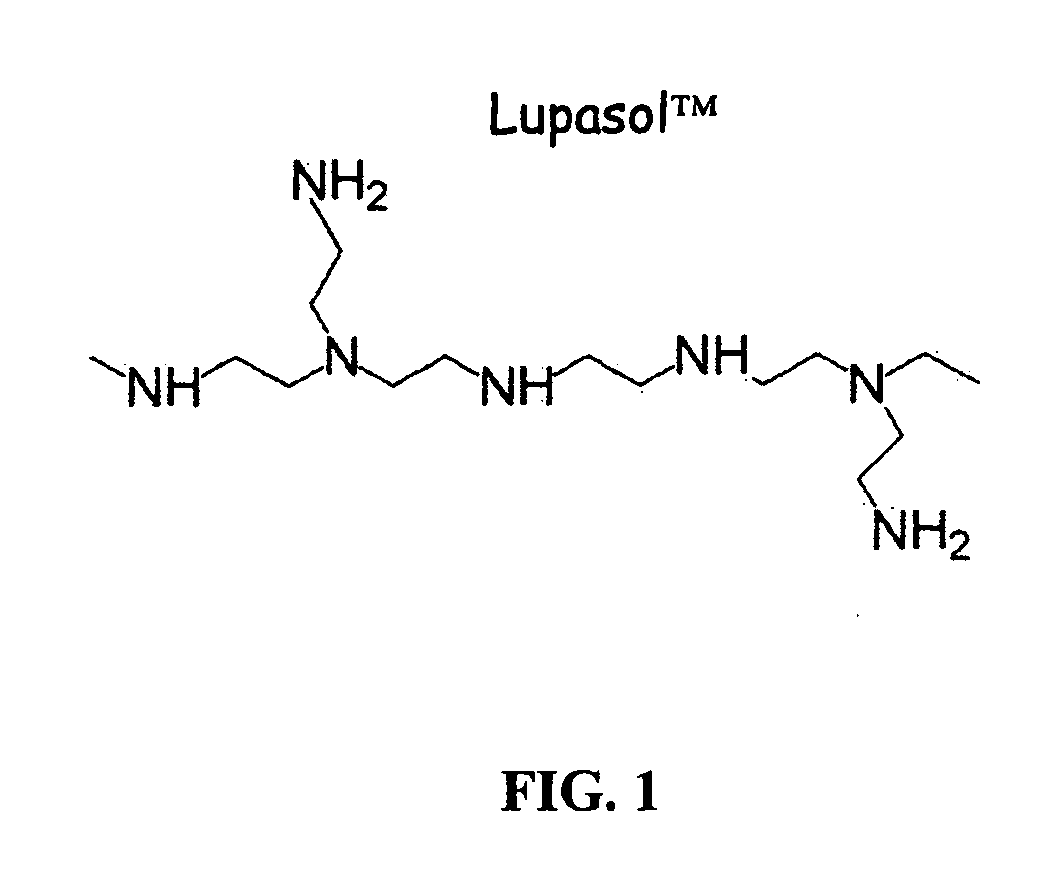Compositions and method for targeted controlled delivery of active ingredients and sensory markers onto hair, skin and fabric
a technology of active ingredients and sensory markers, applied in the field of controlled release carrier systems, can solve the problems of not being able to extend capsules have not been commercially successful in extending the release of perfume from fabrics, and types of particles cannot be incorporated into aqueous fabric softener compositions, etc., to achieve enhanced nano-sphere deposition, and high cationic charge density
- Summary
- Abstract
- Description
- Claims
- Application Information
AI Technical Summary
Benefits of technology
Problems solved by technology
Method used
Image
Examples
example 1
[0127] The fragrance used in the following examples 1-8 is a fragrance composition that is not substantive on hair when used as neat oil. The fragrance composition used is as follows:
Perfume CompositionComponent (% Wt.)Geraniol30.0Dihydro Myrcenol20.0Phenyl Ethyl Alcohol5.0Linalool25.0Tetrahydro Linalyl Acetate20.0
[0128] The nano-spheres had the following composition; Incroquat Behenyl HE, behenamidopropyl hydroxyethyl dimonium chloride (a fatty quaternary ammonium salt, commercially available from Croda) was used as cationic conditioning agent and LUPASOL™ PR815, a polyethyleneimine having an average molecular weight of 1800 (commercially available from BASF Corporation) was used as a cationic charge booster. The hydrophobic polymer was candelilla / silicon copolymer (commercially available from Strahl & Pitsch Inc.) The suspension is homogenized using an APV, Rannie 2000 high pressure homogenizer. The resulting formulation is: [0129] 64.9% water [0130] 20% candelilla / silicon copol...
example 2
[0137] The nano-spheres had the following composition; Incroquat Behenyl HE, behenamidopropyl hydroxyethyl dimonium chloride (a fatty quaternary ammonium salt, commercially available from Croda) was used as cationic conditioning agent. The hydrophobic polymer was polyethylene homo-polymer (commercially available from New Phase Technologies.) The suspension is homogenized using an APV, Rannie 2000 High Pressure Homogenizer. The resulting formulation is: [0138] 60% water; [0139] 10% fragrance; [0140] 10% Incroquat [0141] Behenyl HE 20% [0142] polyethylene [0143] 200 grams of polyethylene polymer is placed in an oven at 120° C. and allowed to melt. 600 grams of deionized water is placed into one gallon vessel of the homogenizer, that fitted with an all-purpose silicon rubber heater (Cole-Palmer Instrument Company). The water and the aqueous solution is heated to 95° C. The polyethylene polymer is removed from the oven, 100 grams of Incroquat Behenyl HE and 100 grams of fragrance are mi...
example 3
[0144] The nano-spheres had the following composition; Incroquat Behenyl HE, behenamidopropyl hydroxyethyl dimonium chloride (a fatty quaternary ammonium salt, commercially available from Croda) was used as cationic conditioning agent. The hydrophobic polymer was polyethylene homo-polymer, PERFORMA V™ 216 (commercially available from New Phase Technologies.) The suspension is homogenized using an APV, Rannie 2000 High Pressure Homogenizer. The resulting formulation is: [0145] 60% water; [0146] 10% Retinol (commercially available from BASF) [0147] 10% Incroquat Behenyl HE 20% PERFORMA V™ 216 [0148] 200 grams of polyethylene polymer is placed in an oven at 120° C. and allowed to melt. 600 grams of deionized water is placed into one gallon vessel of the homogenizer, that fitted with an all-purpose silicon rubber heater (Cole-Palmer Instrument Company). The water and the aqueous solution is heated to 95° C. The polyethylene polymer is removed from the oven, 100 grams of Incroquat Beheny...
PUM
| Property | Measurement | Unit |
|---|---|---|
| melting point | aaaaa | aaaaa |
| average particle diameter | aaaaa | aaaaa |
| particle diameter | aaaaa | aaaaa |
Abstract
Description
Claims
Application Information
 Login to View More
Login to View More - R&D
- Intellectual Property
- Life Sciences
- Materials
- Tech Scout
- Unparalleled Data Quality
- Higher Quality Content
- 60% Fewer Hallucinations
Browse by: Latest US Patents, China's latest patents, Technical Efficacy Thesaurus, Application Domain, Technology Topic, Popular Technical Reports.
© 2025 PatSnap. All rights reserved.Legal|Privacy policy|Modern Slavery Act Transparency Statement|Sitemap|About US| Contact US: help@patsnap.com



